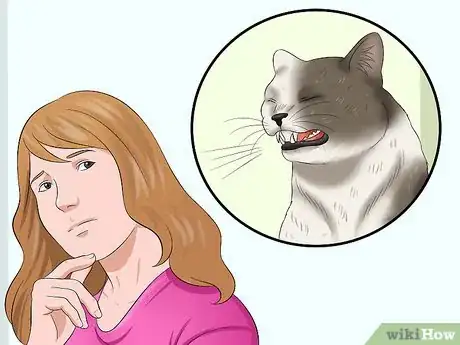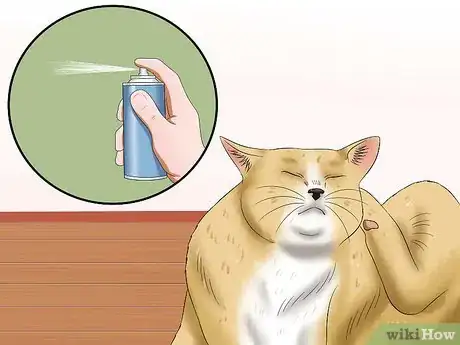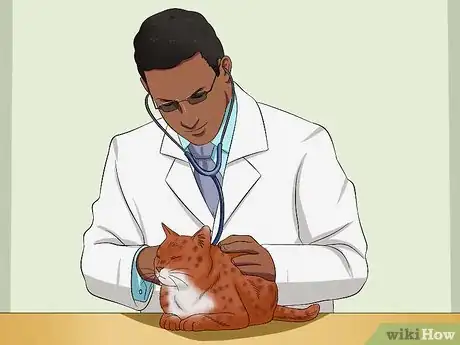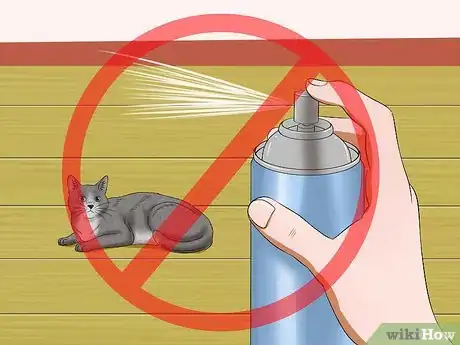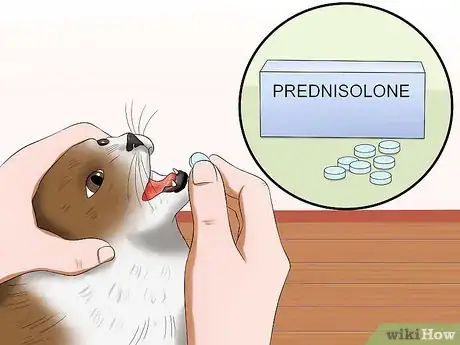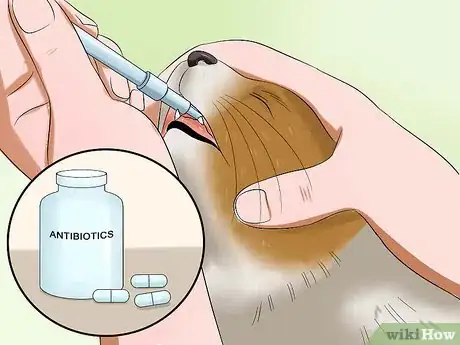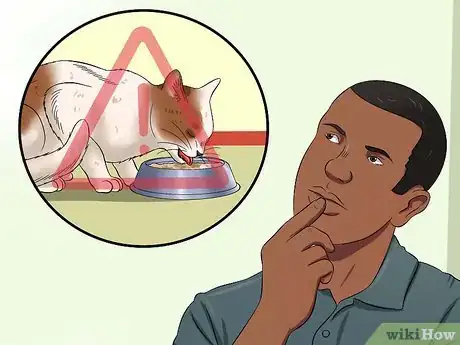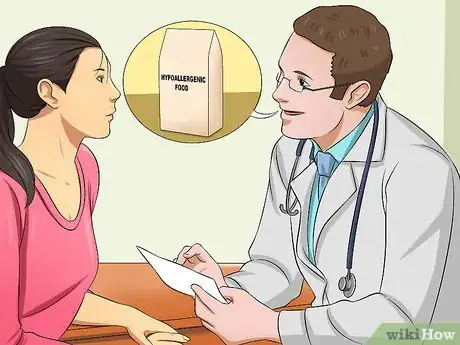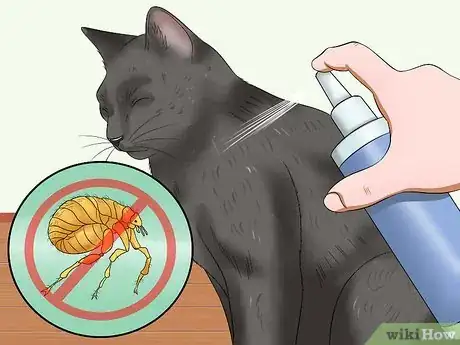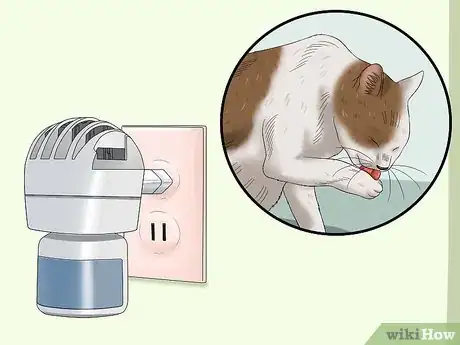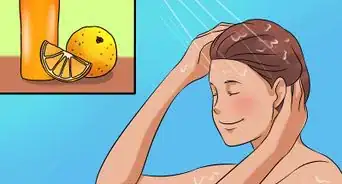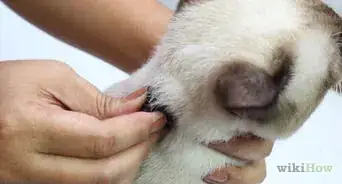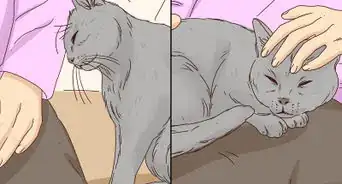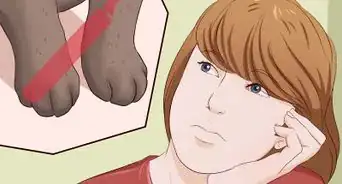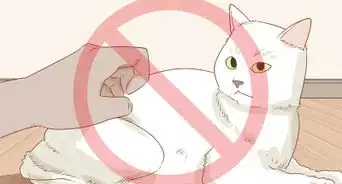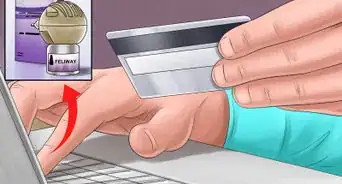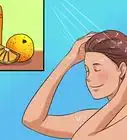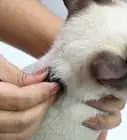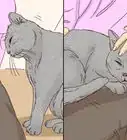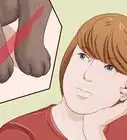This article was co-authored by Pippa Elliott, MRCVS. Dr. Elliott, BVMS, MRCVS is a veterinarian with over 30 years of experience in veterinary surgery and companion animal practice. She graduated from the University of Glasgow in 1987 with a degree in veterinary medicine and surgery. She has worked at the same animal clinic in her hometown for over 20 years.
wikiHow marks an article as reader-approved once it receives enough positive feedback. This article has 13 testimonials from our readers, earning it our reader-approved status.
This article has been viewed 455,423 times.
Cats are fastidious when it comes to keeping their coat in tip-top condition. However, sometimes they go too far, pulling an excessive amount of hair out. This can lead to the cat having a ragged appearance to his coat or even having bald patches. To stop a cat from pulling its hair out you need to get to the bottom of why it's doing it in the first place. The answer to this is unfortunately not always obvious or straightforward.[1]
Steps
Assessing if Environmental Allergens Are a Factor
-
1Understand pet allergies. If humans have an allergy, say for instance hay fever, we tend to get sore eyes, a runny nose, and sneeze. Cats, however, react differently. The commonest manifestation of an allergy in cats is itchy skin, which in turn results in excessive grooming and pulling hair out.
- In much the same way that some people have a peanut allergy, or a seafood allergy, or get hay fever, a cat may be allergic to one substance and be fine with another.
-
2Explore possible environmental allergens. Potentially anything in the environment can be an allergen if the cat is sensitive to it. Common allergens include house dust mites, grass pollens, tree pollens, and flea bites.[2]
- If your cat has an allergy to pollen, you may notice their over-grooming becomes worse in the seasons when that pollen is around, such as in the spring for trees, or summer for grasses. There is also a wide overlap in reaction to many pollens and so it might be the cat only gets relief in the winter, when there are very few pollens around to trigger the reaction.
- Other substances act as irritants (subtly different from an allergy, but producing the same effect). This might be things like spray deodorants, perfumes, or hairspray that are used near the cat and land on their coat, causing irritation.
Advertisement -
3Eliminating possible environmental causes. Unfortunately, it is notoriously difficult to diagnose the exact allergen which the cat is reacting against. Blood tests or skin prick tests that can be run on dogs, yield almost random (and very unreliable) results in the cat.[3] This means your veterinarian will reach a diagnosis by eliminating other possible causes of skin irritation (such as parasites, food allergy, and behavioral causes) and then seeing if the over-grooming settles with treatment.
Treating Environmental Allergies
-
1Minimize exposure to suspected allergens. Remove as many possible causes of allergy or irritation as possible. Do not spray aerosols near the cat, stop using scented candles (the odor clings to fur and can trigger grooming to get rid of it), air fresheners, and vacuum daily to decrease house dust mite numbers.
- The effectiveness of this approach may be limited if the cat reacts to pollens, in which case drug therapy may be required.
-
2Use anti-inflammatories to decrease irritation. The vet will first make a judgement call as to whether treatment is necessary or not. The drugs used to decrease itch can have side effects and your vet should make an educated decision about whether the benefits outweigh the risks.
- If the cat is pulling its fur out and making the skin inflamed, red, infected, or ulcerated, then drug therapy is indicated. If it's a case of a few shorter furred areas, then it probably isn't. The decision to treat or not is one for you to decide in consultation with your vet.
- The drugs commonly used are anti-inflammatories. Corticosteroids such as prednisolone are cheap and effective. An average-sized cat is usually given a 5 mg tablet once daily with or after food for 5 to 10 days (depending on how itchy they are) and the dose reduced to one tablet every other day for the duration of the pollen season.
- Where possible, medication is stopped over the winter. Whilst cats are relatively resistant to the side effects of steroids, when compared to people or dogs, the risk includes increased thirst and appetite (leading to weight gain), and an increased risk of developing diabetes mellitus (sugar diabetes). You should discuss your cat's individual risk of side effects with your veterinarian.[4]
-
3Treat your cat with antibiotics if their skin becomes infected. Antibiotics may be necessary if your cat has pulled the fur out and made the skin sore or infected. In this case, the skin may glisten, or appear moist, there may be a sticky discharge or the area smells.
- You can help at home by gently bathing the infected area twice a day with a saltwater solution and then patting the skin dry. To make up a saltwater solution, boil the kettle, then dissolve one teaspoon of regular table salt into one pint of previously boiled water. Keep this solution in a clean container and soak a clean ball of cotton wool each time.[5]
Investigating and Treating Other Possible Allergens
-
1Explore the possibility that your cat has a food allergy. Another common cause of skin irritation, which results in pulling out fur, is a food allergy. When the cat eats a food they are allergic to, this triggers a mechanism that makes the skin intensely itchy. These allergies are usually to a particular protein in the diet (like a nut allergy in people).
-
2Put your cat on a new diet if a food allergy is indicated. The good news about food allergy is that by avoiding the food allergen the cat can be 'cured' and stops being itchy. However, once again, there is no reliable lab test for food allergy. A diagnosis is made by putting the cat onto a low allergy or hypoallergenic diet.
- The easiest way to put your cat on a hypoallergenic diet is to speak to your vet about a prescription diet. Diets such as Hills DD, Hills ZD, Hills ZD ultra, or Purina HA are made in such a way that the protein molecules it contains are too small to physically bridge receptors in the gut wall that trigger an allergic reaction.
- The alternative is to analyze all the food your cat eats and then find a food that contains NONE of those previous ingredients.
- It can take up to 8 weeks for the previous allergen to clear the system and the symptoms subside, so don't expect a quick result. Whilst on the dietary trial, you must feed the hypoallergenic diet exclusively, so that you don't accidentally give a treat containing an allergen.
- If the cat does have a food allergy, your choices are either to continue feeding the hypoallergenic diet or to add in one new food every fortnight and wait to see if the itching restarts, before declaring that food is OK for your cat.
-
3Assess whether your cat has a flea allergy. A common cause of skin irritation are parasites, especially fleas. When a flea bites it injects saliva into the cat's skin, which acts as a potent allergen. If your cat pulls its hair out, it is a basic requirement to treat the cat monthly against fleas, and use an environmental spray to eliminate flea eggs and larvae in the house.[6]
- Examples of effective products are fipronil, available without a prescription, and selamectin, which is called Revolution in the US and Stronghold in the UK, and is available with a prescription only.[7] Use a treatment regardless of whether you see evidence of fleas or not. This is because it only takes one flea bite to trigger the reaction, and since the flea doesn't live on the pet, he may be long gone and yet the cat is still itchy.
-
4Identify the possible causes of a behavioral problem. When a cat grooms the body releases endorphins, which are a natural form of morphine. This makes the cat feel good and many cats over-groom specifically because they get hooked on the endorphins. This is especially true if the cat feels stressed for some reason because the licking offers a form of stress relief.[8]
- Try to identify why the cat is stressed. Perhaps there has been an intruder cat in the house, or you've recently got a new pet. Addressing the underlying cause is likely to be the answer.
- In addition, you can use Feliway, which is a synthetic version of the feline pheromone (chemical messenger) which makes the cat feel safe and secure. Feliway comes as a spray and a room diffuser, and the later is the best option because it works constantly in the background.[9]
Expert Q&A
Did you know you can get expert answers for this article?
Unlock expert answers by supporting wikiHow
-
QuestionMy cat doesn't groom herself but instead pulls out clumps of hair. I can see tiny white specks in her fur. What should I do?
 Pippa Elliott, MRCVSDr. Elliott, BVMS, MRCVS is a veterinarian with over 30 years of experience in veterinary surgery and companion animal practice. She graduated from the University of Glasgow in 1987 with a degree in veterinary medicine and surgery. She has worked at the same animal clinic in her hometown for over 20 years.
Pippa Elliott, MRCVSDr. Elliott, BVMS, MRCVS is a veterinarian with over 30 years of experience in veterinary surgery and companion animal practice. She graduated from the University of Glasgow in 1987 with a degree in veterinary medicine and surgery. She has worked at the same animal clinic in her hometown for over 20 years.
Veterinarian The white specks could be dander (flakes of dead skin) or a parasite such as lice or cheyletiella. The parasites need to be identified by a vet, and you should use an appropriate product to treat them. If the specks are dander, this indicates her skin is in poor condition. Brush her daily to improve the circulation to her skin, and add an Omega fish oil supplement to her diet. Also check there are no knots in her coat, which stop her from grooming down to the skin.
The white specks could be dander (flakes of dead skin) or a parasite such as lice or cheyletiella. The parasites need to be identified by a vet, and you should use an appropriate product to treat them. If the specks are dander, this indicates her skin is in poor condition. Brush her daily to improve the circulation to her skin, and add an Omega fish oil supplement to her diet. Also check there are no knots in her coat, which stop her from grooming down to the skin. -
QuestionMy itches, chews, and pulls her fur out. I used a flea product, but all the vet's tests came back normal. Is there something I can apply to stop the itching?
 Pippa Elliott, MRCVSDr. Elliott, BVMS, MRCVS is a veterinarian with over 30 years of experience in veterinary surgery and companion animal practice. She graduated from the University of Glasgow in 1987 with a degree in veterinary medicine and surgery. She has worked at the same animal clinic in her hometown for over 20 years.
Pippa Elliott, MRCVSDr. Elliott, BVMS, MRCVS is a veterinarian with over 30 years of experience in veterinary surgery and companion animal practice. She graduated from the University of Glasgow in 1987 with a degree in veterinary medicine and surgery. She has worked at the same animal clinic in her hometown for over 20 years.
Veterinarian Itching in cats is caused by one of the following: parasites (such as fleas), allergies (such as to food or pollens in the environment) or behavior (usually stress related or boredom). Lab test for food allergy can give unreliable results, so try giving your cat a hypoallergenic diet. If this makes no difference after 8-12 weeks, then you need to review her lifestyle to see if she is stressed, bored, or being bullied, as correcting this will help resolve the itching. Topical treatments are unlikely to help.
Itching in cats is caused by one of the following: parasites (such as fleas), allergies (such as to food or pollens in the environment) or behavior (usually stress related or boredom). Lab test for food allergy can give unreliable results, so try giving your cat a hypoallergenic diet. If this makes no difference after 8-12 weeks, then you need to review her lifestyle to see if she is stressed, bored, or being bullied, as correcting this will help resolve the itching. Topical treatments are unlikely to help.
References
- ↑ Feline Behaviour for Veterinarians. Bonnie Beaver. Publisher: Saunders
- ↑ BSAVA Manual of Canine and Feline Dermatology. Jackson & Marsella. Publisher: BSAVA Publications.
- ↑ BSAVA Manual of Canine and Feline Dermatology. Jackson & Marsella. Publisher: BSAVA Publications.
- ↑ Plumb's Veterinary Drug Handbook. Donald Plumb. Publisher: Wiley-Blackwell
- ↑ Plumb's Veterinary Drug Handbook. Donald Plumb. Publisher: Wiley-Blackwell
- ↑ BSAVA Manual of Canine and Feline Dermatology. Jackson & Marsella. Publisher: BSAVA Publications.
- ↑ https://www.zoetisus.com/_locale-assets/mcm-portal-assets/products/pdf/revolution-prescribing-information.pdf
- ↑ Feline Behaviour for Veterinarians. Bonnie Beaver. Publisher: Saunders
- ↑ http://www.pattersonvet.com/msds/078335521
About This Article
To stop a cat from pulling its hair out, remove possible allergens and irritants, as they can cause itchy skin that leads to over-grooming. Vacuum daily to reduce dust and pollen, which are potential allergens. A vet prescribed anti-inflammatory can also decrease irritation to the skin. However, if the cat’s skin begins to glisten or produce a moist discharge, it is likely infected. Ask your vet about antibiotics and bathe the area twice a day with a salt water solution. To learn more about the symptoms and cures for flea allergies and behavioral problems, keep reading our veterinary reviewer’s advice!
